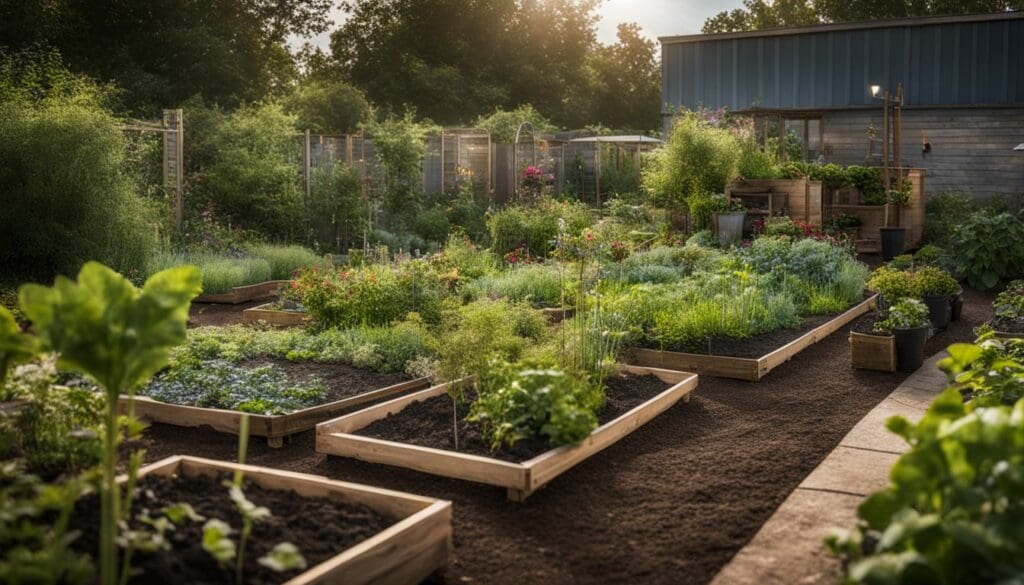Why Start a Community Garden?
Starting a community garden provides numerous benefits to both the environment and local communities. By establishing a community garden, individuals can actively contribute to sustainable food production while fostering a sense of camaraderie within their neighbourhoods.
Community gardens also serve as valuable educational resources, offering opportunities to learn about horticulture, biodiversity conservation, and the benefits of sustainable food systems.
Moreover, they can enhance urban green spaces and contribute towards creating a healthier environment for all.
Community gardens play an essential role in supporting environmental conservation efforts by promoting local food production and reducing reliance on long-distance transportation. Additionally, these communal spaces encourage people to engage with nature while cultivating an appreciation for the importance of sustaining biodiversity.
Overall, starting a community garden is not only beneficial for the environment but also enriches the lives of those involved by cultivating meaningful connections with each other and the natural world around them.
Steps to Starting a Community Garden
Find available land, engage your community, gather resources and support, decide what to plant, prep and build the site, determine and establish rules, and maintain and grow the garden.
Read on to learn more about how you can start a thriving community garden in your area.
Find available land
Look for suitable land in your community by reaching out to local government agencies, schools, or churches. Engage with landowners who are willing to provide space for a community garden.
Explore open areas that receive ample sunlight and have access to water sources. Consider the soil quality and whether it’s suitable for growing plants. Collaborate with others to scout potential sites and secure a location that meets the needs of your community garden project.
Consider factors such as accessibility, safety, and proximity to the target audience when selecting the land. Evaluate if there are any zoning regulations or permits required for gardening activities in the chosen area.
Engage your community
To successfully start a community garden, it’s essential to engage your community. This involves spreading awareness about the benefits of a communal green space and inviting participation from local residents.
Organising meetings or workshops can help gather ideas and feedback from potential gardeners, fostering a sense of ownership and responsibility within the community. Encouraging open communication and collaboration will be key in establishing a shared vision for the garden and ensuring its sustainability.
Once you have identified interested individuals, involve them in decision-making processes such as plant selection, design plans, and maintenance schedules. Involving members from diverse backgrounds can enrich the project with varied perspectives and skill sets.
Prep and build the site
First, assess the selected land’s conditions. Clear debris and rocks from the site to prepare for gardening. Next, layout garden plots and pathways, ensuring they are easily accessible and well-defined.
Prepare the soil by removing weeds, adding organic matter and nutrients for healthy plant growth. Construct raised beds or containers where necessary to optimise space usage and provide suitable growing conditions.
Lay down irrigation systems; consider drip irrigation to efficiently deliver water directly to plant roots while conserving water. Install fencing or barriers as needed to protect plants from pests or animals that could damage them.
Determine and establish rules
Establishing rules is crucial for maintaining a harmonious and productive community garden. Setting clear guidelines regarding planting, maintenance responsibilities, and visitor conduct fosters an environment of respect and cooperation among participants.
By involving the community in establishing these rules, everyone feels invested in the success of the garden.
To ensure that your community garden flourishes, it’s essential to clarify expectations from the outset. This will create a supportive atmosphere where all members feel heard and valued.
Maintaining and growing the garden
To maintain and grow the garden, regularly water the plants and check for any signs of pests or diseases. Make a schedule for weeding, pruning, and fertilising to keep the garden healthy and thriving.
Engage community members in regular maintenance activities to ensure everyone participates in caring for the garden.
Another key aspect of maintaining and growing the garden involves continuously monitoring plant growth, soil quality, and weather conditions. Encourage ongoing learning within the community about sustainable gardening practices through workshops, educational events, and information sharing.
Benefits of Having a Community Garden
– Promotes local, nourishing foods and healthy eating habits.
– Enhances social connections and community engagement.
Promotes local, nourishing foods
Community gardens promote local, nourishing foods by providing access to fresh produce grown right in the neighbourhood. People can enjoy a variety of fruits, vegetables, and herbs that are locally sourced and sustainably grown.
This not only supports a healthier diet but also reduces the carbon footprint associated with transporting food from distant locations.
Moreover, community gardens cultivate a sense of connection to the land and an appreciation for where food comes from. By participating in growing their own produce or sourcing it from nearby gardens, individuals can engage in sustainable practices while supporting local farmers and growers.
Enhances social connections
Connecting over a shared passion for gardening fosters meaningful relationships within the community. Working side by side in a communal garden provides opportunities to bond, share knowledge, and exchange ideas with like-minded individuals.
This collaborative environment creates a strong sense of belonging, creating lasting friendships and promoting social cohesion among community members.
Engaging in collective activities such as planting, watering, and harvesting instils a sense of camaraderie and teamwork. Furthermore, community gardens often host events and workshops that bring people together to celebrate their achievements and reinforce the value of cooperation in nurturing their shared green space.
Education and learning opportunities
By cultivating a community garden, individuals have the chance to engage in educational activities related to horticulture, environmental science, and sustainable farming practices.
Participants can attend workshops on seed starting, organic gardening methods, and composting to gain practical knowledge about growing healthy produce while making positive impacts on the environment.
Engaging in a community garden also provides opportunities for children and adults alike to learn about plant life cycles, seasonal planting schedules, and the importance of pollinators in our local ecosystems.
Improves the environment
Community gardens contribute positively to the environment by promoting biodiversity, reducing carbon footprint, and conserving natural resources. They provide habitat for pollinators and other beneficial insects, which helps to maintain a balanced ecosystem.
By cultivating organic fruits and vegetables within the community garden, it reduces the need for transportation and packaging associated with store-bought produce. Additionally, composting organic waste from the garden leads to reduced landfill usage.
Harvested rainwater in community gardens helps reduce water wastage while improving soil quality through mulching and cover cropping practices. These sustainable methods create healthier ecosystems that benefit local wildlife as well as residents.
Promoting these environmental benefits is crucial in driving awareness of ecological preservation among communities while fostering active participation in sustainable food systems.
Tips for a Successful Community Garden
Utilise social media for advocacy and community engagement, consider pursuing a horticulture degree, encourage biodiversity conservation, prepare for the autumn season, and promote sustainable food systems.
Think about the intersection of people and plants for a thriving community garden.
Utilising social media for advocacy
To effectively advocate for your community garden, consider utilising social media platforms to raise awareness, share updates, and engage with the local community. Develop engaging content such as photos of the garden’s progress, informative posts about sustainable gardening practices, and success stories from community members.
Encourage followers to share posts and get involved in volunteer opportunities at the garden. Utilise hashtags related to conservation and environmental sustainability to reach a wider audience and connect with like-minded individuals who are passionate about supporting green initiatives.
Engage with local influencers or organisations that have an interest in environmental conservation and sustainable living. Collaborate on social media campaigns or events to promote your community garden project.
Examining the intersection of people and plants
Understanding the intricate relationship between people and plants is essential for successful community gardening. By exploring how human actions affect plant life, we can make informed choices about what to grow in our communal spaces.
Studying this intersection helps us create vibrant, sustainable environments that benefit both people and the planet.
When considering the overlap of people and plants, it’s crucial to recognise how our interactions impact ecosystems. Understanding this connection is fundamental for creating thriving community gardens that support local biodiversity as well as human wellbeing.
Considering a horticulture degree
When examining the intersection of people and plants in a community garden, considering a horticulture degree can open up opportunities to deepen your knowledge and skills. Pursuing this path allows for focused learning about plant cultivation, soil management, and sustainable gardening practices.
A horticulture degree equips individuals with the expertise needed to make informed decisions in promoting biodiversity conservation, sustainable food systems, and environmental stewardship within a community garden setting.
Encouraging biodiversity conservation
Encouraging biodiversity conservation helps maintain a healthy ecosystem. Planting a variety of native flora attracts beneficial insects and wildlife, supporting the garden’s natural balance.
By embracing diverse plant species, community gardens create a thriving environment for pollinators, birds, and other vital creatures.
Incorporating diverse plants not only adds beauty but also fosters resilience in the garden. Cultivating different species creates a more robust ecological system that can better withstand environmental challenges.
Preparing for the autumn season
As the autumn season approaches, it’s vital to start preparing your community garden for the changing weather. Start by harvesting any remaining summer crops and clear out any exhausted plants to make space for new varieties suited for fall.
It’s also crucial to begin planting cold-hardy vegetables like kale, spinach, and carrots to ensure a bountiful harvest throughout the upcoming months.
Furthermore, consider adding a layer of mulch around your plants to help regulate soil temperature and moisture levels as the weather turns cooler. Don’t forget to inspect and repair garden structures such as trellises or raised beds before winter sets in.
Promoting sustainable food systems
A community garden promotes sustainable food systems by growing fresh, organic produce locally. By cultivating a variety of fruits, vegetables, and herbs, the garden reduces dependence on commercially grown produce that often requires extensive transportation and may have been treated with harmful pesticides.
This not only benefits the environment but also ensures that the local community has access to nutritious, chemical-free foods. Additionally, promoting sustainable food systems through a community garden encourages responsible land use and helps in reducing greenhouse gas emissions associated with large-scale agricultural practices.
To further promote sustainable food systems within a community garden, consideration can be given to utilising eco-friendly gardening techniques such as composting and water conservation measures.
Conclusion
In conclusion, starting a community garden offers numerous benefits for both the environment and the local community. By following the outlined steps, you can effectively establish a space that promotes social connections, provides educational opportunities, and contributes to sustainable food systems.
Engaging in community gardening is an active way to support conservation efforts and foster environmental awareness among like-minded individuals. With careful planning and dedication, your community garden has the potential to make a positive impact on both people and the planet.
FAQs
1. What do I need to start a community garden?
To start a community garden, you’ll need space for planting, tools, seeds or plants, and a group of interested people.
2. How do I find a suitable location for our community garden?
Look for unused land in your area such as empty lots or parks and get permission from the landowner or local authority.
3. Can anyone join in creating the community garden?
Yes, everyone who is willing to contribute time and effort can join in creating the community garden.
4. What are some important things to consider when planning the layout of our community garden?
Consider sunlight exposure, water accessibility, path placement and the types of plants you want to grow when planning your layout.
5. Is it expensive to maintain a community garden?
The cost can vary but sharing responsibilities among members helps keep maintenance costs down.





